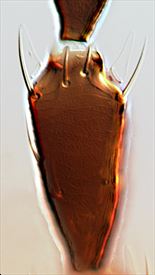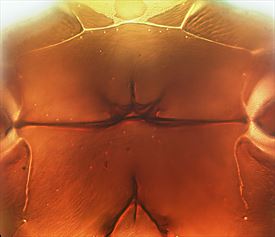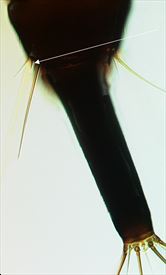
Head & pronotum

Antennal segment IV

Thoracic sternites of small male

Thoracic sternites of large male

Sternopleural sutures

Male tergite IX & tube [seta S2 arrowed]
Distinguishing features
Both sexes fully winged. Body dark brown; fore tarsi and extreme base of antennal segment III paler; wings pale but brown around sub-basal setae. Antennal segments III and IV with sense cones unusually stout, length scarcely 2.5 times basal width. Head with cheeks constricted to base, occipital ridge with prominent paired apophyses; cheeks with several small stout setae; postocular setae arise laterally and far behind eyes. Pronotum unusually short. Anterior margin of mesoeusternum curved in female and small male, but more angulate in large male; metathoracic sterno-pleural sutures long. Metanotum reticulate medially. Fore tarsal tooth present in both sexes, large in large individuals. Fore wing sub-basal setae S3 finely acute, S1 and S2 broadly blunt to capitate. Tergite IX posteromarginal setae S1 and S2 over half as long as tube, S3 as long as tube.
Male similar to female, varying in size; anterior margin of mesoeusternum different in large and small males; sternite VIII pore plate large; tergite IX posteromarginal setae S2 exceptionally short, scarcely 25 microns long.
Related species
There are six species in the genus Cartomothrips, of which three are known only from Australia, one known only from New Zealand, and two that are known from both countries. C. browni has the posterior margin of the head with two prominent apophyses, and as in neboissi, but unlike both manukae and tofti, setal pair S2 on tergite IX of males is exceptionally short, scarcely 25 microns long.
Biological data
Apparently living in the old seed capsules of Eucalyptus grandis and related species.
Distribution data
Australia, Kenya [Mt Kilimanjaro], Brazil [Sao Paulo], California [Riverside], New Zealand [Lincoln] (Mound & Walker, 2012).
Family name
PHLAEOTHRIPIDAE, PHLAEOTHRIPINAE
Species name
Cartomothrips browni StannardOriginal name and synonyms
Cartomothrips browni Stannard, 1962: 39
References
Mound LA & Walker AK (2012) The Australia-New Zealand connection re-visited, with two new species of Cartomothrips (Thysanoptera, Phalaeothripidae). Zootaxa 3487: 58–64.